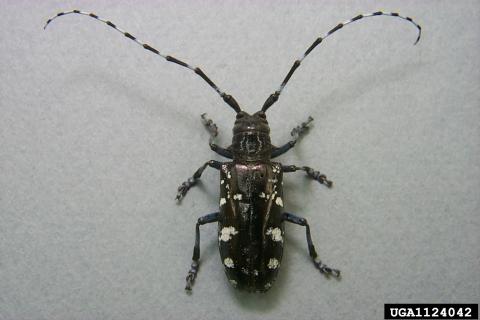Asian Longhorned Beetle Pool Survey

If you have a pool, you can help us look for Asian longhorned beetle. (If you don’t have a pool, you can still help!) UNH Cooperative Extension asks New Hampshire residents with pools to check their filters regularly for Asian longhorned beetle (ALB). This invasive insect is a serious threat to our forests and trees. ALB isn't in New Hampshire yet. Karen Bennett, Extension Forestry Specialist with UNH Cooperative Extension, said, “We need many people looking for it so we can take steps to limit its spread, if it arrives.”
Why should I be concerned about ALB?
ALB was first found in trees in Worcester, Mass., in 2008, but experts estimate it was in the trees for about 10 years before they identified the problem. Some Worcester homeowners subsequently reported they collected ALB in their swimming pools for years prior to the 2008 identification. There are still efforts in Worcester and surrounding towns to eradicate ALB. The process involves the removal and destruction of many thousands of trees. ALB attacks many kinds of hardwood trees.
How can I help look for ALB?
Kyle Lombard, Forest Health Specialist at the N.H. Division of Forests and Lands, said, “Asian longhorned beetles are emerging from trees and those residents with giant insect collectors, also known as ‘swimming pools,’ could help us greatly by paying attention to the debris collected in the filters. If any insect looks similar to a longhorned beetle, they should upload a picture of it.”
To help with this effort, in addition to a swimming pool, you will need:
- A smartphone (or other mobile device) or digital camera.
- An email address that you actively use.
- A computer to upload pictures to our online reporting system.
Help us by looking at the debris from your swimming pools. Here are the steps you can take:
Step 1: Search your pool filter for Asian longhorned beetle
ALB adults are active during the summer, mid-July through the end of August. Whenever you clean your pool, look at the debris you collect in your filter and skimmers. Look for longhorned beetles.
Step 2: Compare what you find to insects similar to ALB
Use a fact sheet to compare collected insects to common insects.
Step 3: Take a picture
Take a picture of any insect you think is a longhorned beetle. We need a good view of the insect's back to properly identify it.
Step 4: Send us your pictures
Upload pictures of the insect using the online reporting form.
Step 5: Save the insect
If you send us a picture, freeze the insect in a tupperware-like container until you hear from us (about a week). We will either tell you to throw the insect out or give you instructions about mailing it, delivering it or arranging for pick-up.
We will post interesting pictures and sightings online at in our photo gallery.
Find more information about Asian longhorned beetle and other invasive insects at www.NHBugs.org.
